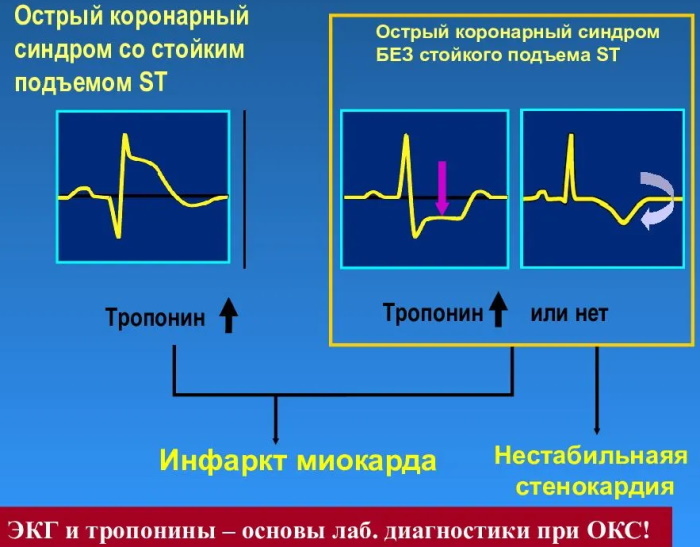Content
- Views
- Symptoms of the disease
- Symptoms of exertional angina
- Rest angina symptoms
- Causes of pathology
- Diagnostics
- Treatment of angina pectoris
- Risk factors
- Hyperlipidemia
- Obesity
- Hypodynamia
- Smoking
- Arterial hypertension
- Anemia and intoxication
- Diabetes
- Increase in the relative viscosity of blood
- Psychoemotional stress
- Possible complications and prevention
- Angina video
Angina of the heart - a dangerous cardiovascular pathology, which is considered a form of chronic ischemic heart disease and arises from insufficient nutrition of the myocardium due to poor vascular patency. Symptoms of the disease can occur in women and men at any age, and are associated with excessive physical loads and severe stressful situations that provoke tachycardia, a burning sensation and pain for sternum.
Another most common cause of angina pectoris is the development of atherosclerosis, associated with the gradual blockage of blood vessels formed in as a result of a sedentary lifestyle and improper diet of cholesterol plaques that interfere with normal blood flow and nutrition of the heart muscles.
If at the end of the 19th and beginning of the 20th century, angina pectoris was quite rare, then with the development of technical and information progress, the number of cases of pathology has increased significantly, turning into a kind of pandemic XXI century.
Previously, angina pectoris was considered a "male pathology", but in recent years, the disease has begun to increasingly affect young women in under the age of 60, forced to constantly live in a stage of chronic stress, eat improperly and work on an equal basis with men.
Views
Symptoms of angina pectoris in women are more pronounced than in men and due to the increased emotionality of the female sex and can resemble vegetative-vascular pathologies. Depending on the moment of onset of pathology, they are distinguished:
| Angina pectoris | This form of the disease is characterized by the appearance of paroxysmal pain in the sternum, increased heart rate and increase in blood pressure as a reaction of the body to strong emotional stress or intense physical load. Increased myocardial oxygen demand due to load or stress almost completely disappears at rest, occurring in approximately 10-14% of women and 20-25% of men aged 35 to 50 years old. |
| Rest angina | In this case, chest pain, asthma attacks and vegetative-vascular manifestations occur in the state complete physical rest, forcing a person to wake up during a calm sleep or manifesting in the morning clock. This form of pathology is considered more dangerous than exertional angina and often occurs in women aged 47-55 years who are faced with symptoms of menopause. |

Some experts also divide rest angina into:
- Prinzmetal's angina, which develops during complete physical rest due to spasm of the coronary arteries and characterized by severe, prolonged seizures that occur during sleep or in the morning when the person is still be in bed.
- Postinfarction angina, manifested by anginal attacks within 24 hours or 2 days from the moment of the suffered heart attack.
According to the classification adopted by the WHO and the All-Union Cardiological Scientific Center (VKNTs) of the USSR Academy of Medical Sciences, there are:
- First-onset angina pectoris - lasting up to 1 month from the moment of first appearance and subsequently regressing, turning into stable or progressive angina pectoris.
- Stable angina pectoris - with a duration of 1 month from the moment of first appearance.
- Progressive, unstable angina pectoris, characterized by the appearance of seizures as a response to the load previously habitual for the patient.
Stable angina pectoris, depending on the patient's ability to endure physical activity, is divided into:
| Grade 1 angina | Typical for women with good exercise tolerance. Attacks here occur only in the case of excessive, intense loads performed at a good pace and for a long time. |
| Grade 2 angina | Here, the patient's physical activity is somewhat limited, and an attack occurs when walking on an equal terrain for more than 500 m and climbing above the 1st floor. Cold wind, emotional arousal and the first hours of sleep can also affect the onset of an attack of pain. |
| Grade 3 angina | It is characteristic of limited physical activity, and an attack appears when walking on flat terrain at 100-200 m and climbing to the 1st floor. |
| Grade 4 angina | Occurs with minimal physical exertion. |
Regardless of the course and development of the disease, angina pectoris at rest is considered a more dangerous pathology than angina pectoris. stress, affects more coronary arteries and more often leads to the development of myocardial infarction and sudden heart death.
Symptoms of the disease
Symptoms of angina pectoris in women directly depend on the state of the hormonal background, which provokes, together with traditional pathology for pain in the sternum and dyspnea; development of dizziness, blurred vision and a feeling of fear of death.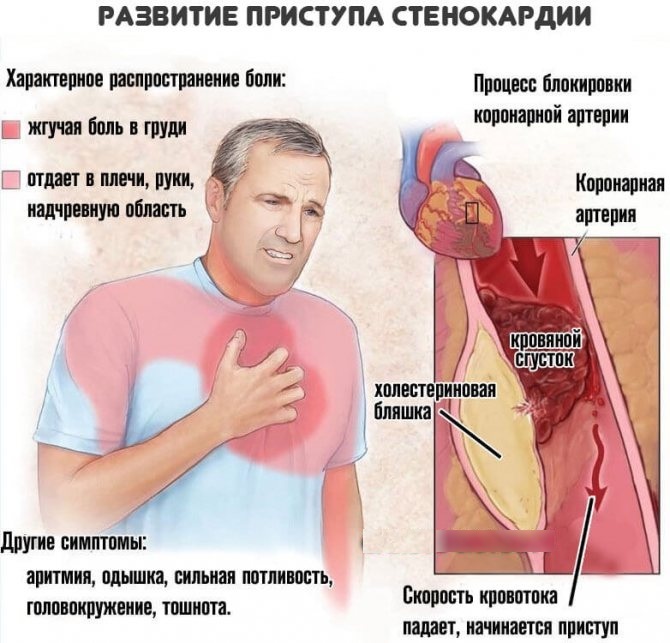
Depending on the type of pathology, angina pectoris in women can occur both as a result of strong emotional stress, and at the time of restful sleep, but it is always accompanied by:
- Feeling of discomfort and pain in the chest, characterized by a compressive and oppressive character. In colloquial practice, this, considered the main symptom of angina pectoris, is called "angina pectoris" because, according to survivors, it resembled the feeling “as if a huge toad had sat on the chest and interfered calmly breathe".
- "Radiating pain", weakness, a feeling of numbness, manifested in the left hand, neck, jaw.
- Tachycardia.
- Increased blood pressure.
In addition to the general symptoms, the hormonal reaction of the female body also causes when an attack of angina pectoris occurs:
- a feeling of fear of death;
- feeling of lack of oxygen;
- shortness of breath.
If an attack occurs due to stress or physical exertion, it has a cramping character and gradually subsides at rest. An attack that occurs during the stage of REM sleep or in the morning hours makes the patient wake up from acute suffocation or a feeling of tightness in the chest.
Symptoms of exertional angina
Symptoms of exertional angina can vary in intensity from a vague feeling of discomfort behind the breastbone to intense, gradually increasing pain in the heart. The attack lasts from 2 to 5 minutes, has a clear beginning and end and stops after the disappearance of the factor that provoked it.
In addition to pain, described by survivors as “pressing, constricting, cutting, or burning,” the seizure is accompanied by:
- sudden weakness;
- shortness of breath;
- tachycardia;
- arrhythmia;
- cold sweat;
- increase or decrease in blood pressure.
In the intervals between attacks, the woman's condition can be described as normal, and at the beginning of the next attack, the symptoms return.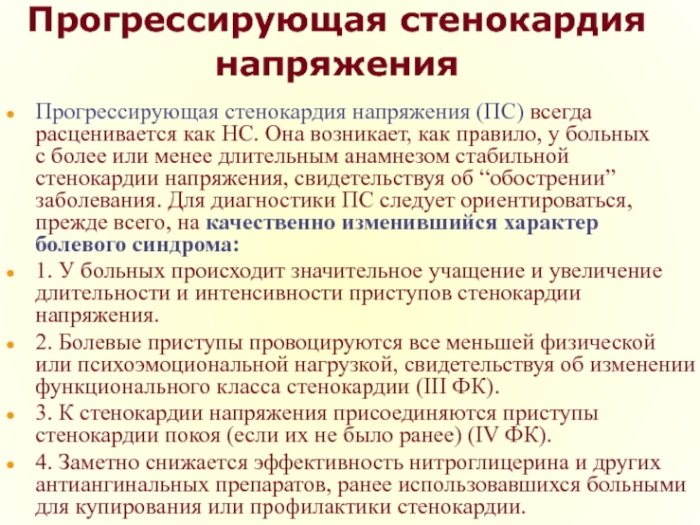
The number of angina attacks is different for each patient and can vary from several during the day, and from 1-2 within 2 weeks or a month.
Rest angina symptoms
A sudden attack of angina pectoris can strike a woman in REM sleep, and women who have experienced such an attack previously noted that they had to run or lift weights in their sleep. This state of affairs is connected with the fact that according to modern researchers, the phase of REM sleep represents is an endogenous stress, accompanied by arousal of the autonomic nervous system and the release catecholamines.
An attack of rest angina is always preceded by a state of increased anxiety, anxiety or fear of death. The pain syndrome here is intense, located strictly behind the sternum, gradually squeezing the breath and moving on to the left arm, scapula and left part of the jaw. The pain arising from angina pectoris at rest makes a woman literally freeze in one position, since any slightest movement causes additional suffering.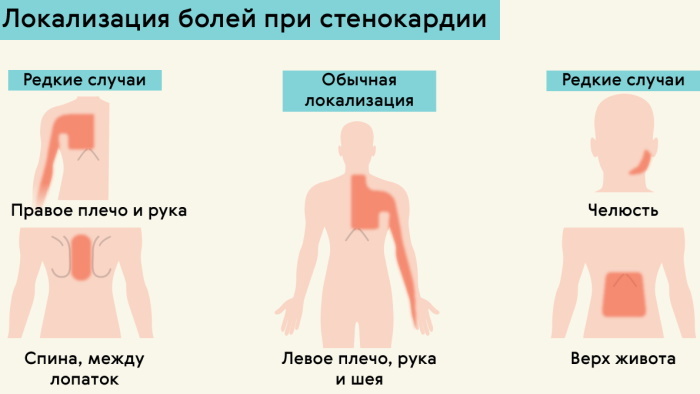
The anginal attack lasts approximately 5-15 minutes, accompanied by:
- tachycardia;
- an increase in the physical indicators of blood pressure;
- increased breathing;
- heavy sweating;
- severe pallor or hyperemia of the skin;
- nausea;
- dizziness.
Often an attack of angina pectoris at rest is preceded by exertional angina pectoris, which has arisen due to a strong nervous shock or intense physical training.
Causes of pathology
The main reason for the development of angina pectoris is considered to be atherosclerosis - narrowing of the coronary vessels caused by a decrease in the lumen of the vessels more than 50-70% due to the formation of cholesterol plaques, provoked by excessive deposition of blood contained in cholesterol. The less vascular patency, the more severe angina pectoris proceeds. Its intensity is also influenced by the number of affected arteries, the presence or absence of blood clots and arterial spasms.
Atherosclerosis, as the main cause of the development of angina pectoris, can be caused by both genetic characteristics of the body and a violation of lipid-fat cancellation, which occurs when:
- diabetes mellitus, thyroid hypothyroidism, hyperfunction of the adrenal cortex, lipodystrophy;
- problems with the gallbladder and cirrhosis of the liver;
- chronic impairment of renal excretory function;
- peculiarities of lifestyle and nutrition;
- taking medications that contribute to the development of atherosclerosis.
Of no small importance for the development of atherosclerosis are:
- sedentary lifestyle;
- unhealthy diet (tendency to salty, fatty, heavy foods);
- being overweight (obese);
- smoking and alcohol abuse.
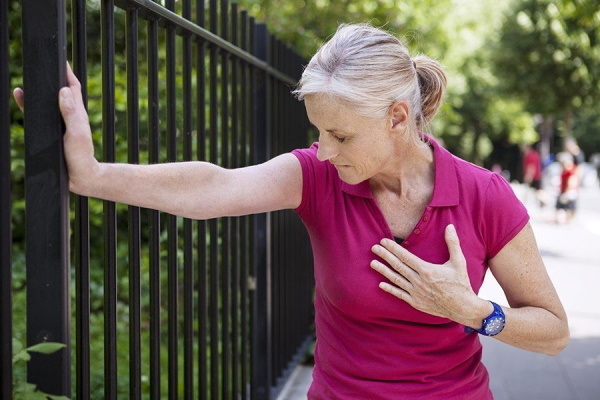
In women, the appearance of angina pectoris, in addition to the formation of cholesterol plaques, can be triggered by vasodilation and excessive blood pressure that occurs at the level of small vessels and is caused by:
- nicotine addiction;
- dyslipidemia;
- insulin resistance;
- a decrease in the production of sex hormones in women, which occurs during the premenopausal period;
- chronic stress or inflammatory reactions.
In rare cases, angina pectoris is characterized by the development of cardiospasm caused by a violation of the nervous regulation of the venous arteries of the heart.
In this case, one should talk about reflex angina pectoris, which develops as a complication:
- diaphragmatic hernia, gallstone disease and other pathologies of the gastrointestinal tract;
- infectious and allergic diseases;
- syphilitic and rheumatoid vascular lesions, including aortitis, periarteritis, vasculitis, endarteritis.
The condition of the blood itself, or rather the lack of red blood cells in it, which causes oxygen starvation not only of the heart muscle, but also of the whole organism, can provoke the development of angina pectoris.
Diagnostics
Symptoms of angina pectoris in women, manifested at the time of walking, climbing stairs or at night sleep make the patient freeze in place, pressing his hand in his chest and feel first an increase, and then a decrease pulse. This condition can last from 1 to 20 minutes and requires immediate medical attention.
Diagnosis of the problem begins from the moment of visiting a cardiologist, whose task is to collect the maximum the amount of information about the patient's condition, as well as give a referral for an ECG, laboratory tests and others research.
So the process of diagnosing angina pectoris consists of:
| Laboratory research |
|
| ECG |
|
| Echocardiography | Reveals local ischemic changes and violations of myocardial contractility. |
| Velgoergometry | A test showing what maximum physical activity the patient can endure before the onset of an angina attack. It is carried out by means of an exercise bike and an ECG apparatus. |
| Myocardial scintigraphy | It is performed to visualize the perfusion of the heart muscle and identify focal changes in it. |
| Diagnostic coronary angiography | Helps to assess the localization, degree and extent of damage to the arteries of the heart. |
| Chest x-ray | It is prescribed only if there is reason to assume the presence of pulmonary pathology or heart failure. Angina therapy is aimed primarily at relieving painful symptoms, as well as preventing further attacks and the development of dangerous complications. |
Treatment of angina pectoris
First aid for the onset of an attack consists in taking a few drops of nitroglycerin applied to a piece of refined sugar, which should be kept in the mouth until it is completely dissolved. Disappearance of pain occurs within 2-3 minutes. If the attack cannot be stopped, repeated use of nitroglycerin is indicated, but no more than 3 times a day due to the danger of a sharp decrease in blood pressure.
In addition to emergency, planned drug therapy is carried out, with the goal of stopping the development of coronary artery disease, preventing myocardial infarction and increasing life expectancy.
Focusing on this treatment, in most cases inpatient, is aimed at:
- Prevention of the progression of atheroma and the formation of new plaques.
- Reducing inflammation and improving endothelial function.
- Prevention of thrombus formation due to possible rupture of the plaque.
- Restoration of a damaged artery if it supplies a large area of the myocardium.
To achieve these goals, therapy is carried out, including the intake of anti-ischemic drugs aimed at lowering myocardial demand for oxygen doses:
- prolonged-release nitrates (Pentaerythrityl tetranitrate, Isosorbide dinitrate);
- b-blockers (Anaprilin, Oxprenolol);
- calcium channel blockers (Verapamil, Nifedipine);
- drugs that dilate blood vessels (Molsidomin);
- medicines needed to maintain the metabolism of heart cells (trimetazidine).
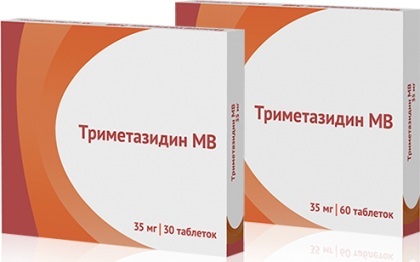
The dosage and course of treatment in each case is prescribed by a cardiologist.
Simultaneously with cardiac drugs are prescribed:
- anti-sclerotic drugs (Lovastatin, Simvastatin);
- antioxidants (tocopherol);
- antiplatelet agents (acetylsalicylic acid);
In severe cases, with complete obstruction of the cardiac arteries, surgical intervention is indicated:
- Balloon angioplasty, in which a coronary artery is expanded with a balloon catheter and then a metal tube is inserted into it.
- Coronary artery bypass grafting, which allows you to create a bypass path of blood flow using venous or arterial shunts.
In addition to taking medications, women suffering from angina attacks should:
- avoid physical exertion and stress that causes bouts of pain;
- quit smoking and other bad habits;
- follow a doctor's recommended diet (for example, Mediterranean) to normalize lipid levels;
- avoid self-medication with pharmacological drugs,
- learn to minimize the effects of stress;
- follow the doctor's recommendations for dosed physical activity on a regular basis.
Risk factors
Symptoms of angina pectoris in women are the main symptom of progressive atherosclerosis, hormonal imbalance or poor functioning of small vessels. According to studies carried out by cardiologists, it was found that the development of angina pectoris in some cases can be prevented by focusing on the identified removable and unremovable risk factors for pathology.
Unmodified (fatal) risk factors in this case include gender, age and heredity.
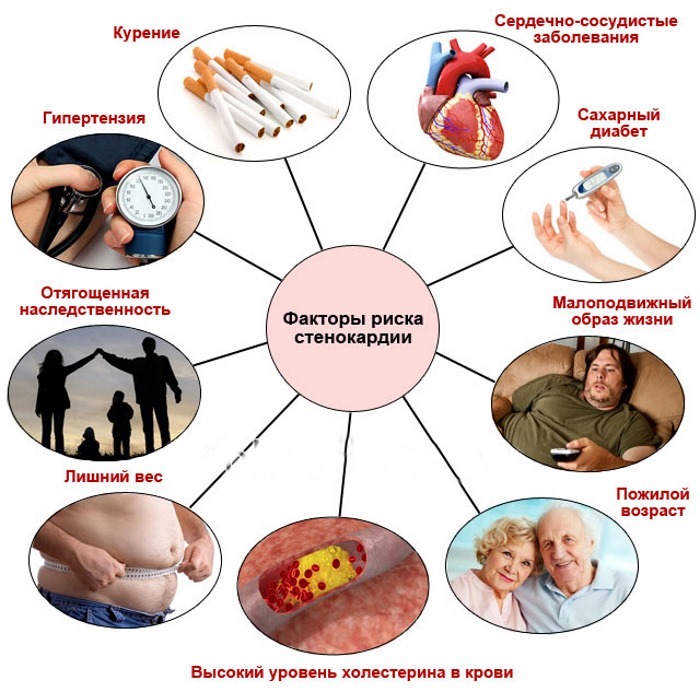
During the studies, it was found that men under the age of 50-55 years are more at risk of developing angina pectoris than women in the same age group. These indicators persist until the end of menopause, after which the amount of estrogen produced in the blood, which previously protects the heart and blood vessels, is significantly reduced in women. From 55 years of age, the number of cases of angina pectoris in both sexes does not differ significantly. It was also noticed that the risk of developing angina pectoris is much higher in patients whose relatives suffered from coronary artery disease or had myocardial infarction.
Unlike fatal ones, modified risk factors can be prevented by eliminating the likelihood of developing angina pectoris. These include:
Hyperlipidemia
Excessive fat in the blood is a direct path to the development of atherosclerosis, which is considered a harbinger of angina pectoris. Along with the high level of fat in such patients, who, as a rule, have reached the age of 35-40 years, there is also a high level of cholesterol, which later becomes the cause of the appearance of plaque and blockage of blood vessels, as well as life-threatening, thrombus formation.
Obesity
One of the main problems of modern society, affecting both women and men equally and associated with excessive consumption of high-calorie foods, saturated fats and simple carbohydrates. To prevent the development of angina pectoris, overweight women need to carefully monitor their diet, we will reduce the amount of cholesterol consumed daily up to 300 mg, table salt up to 5 g, at the same time increasing the amount of eaten by 30 g fiber.
Hypodynamia
Insufficient physical activity, combined with a passion for fatty foods, baked goods and confectionery leads to the gradual development of obesity and impaired lipid metabolism, further leading to the development angina pectoris.
Smoking
Nicotine contained in cigarettes, when ingested, increases the concentration of carboxyhemoglobin in the blood - a compound carbon monoxide and hemoglobin, which cause oxygen starvation of cells, primarily cardiomyocytes, arterial spasm, increased HELL.  With the addition of atherosclerosis, this condition leads to the early development of cardiovascular pathologies and ischemic heart disease.
With the addition of atherosclerosis, this condition leads to the early development of cardiovascular pathologies and ischemic heart disease.
Arterial hypertension
Frequent satellite and one of the signs of ischemic heart disease, causing voltage when the upper values of blood pressure increase myocardium, which increases the oxygen demand of the heart muscle and thereby provokes the development angina pectoris.
Anemia and intoxication
Lack of red blood cells leads to oxygen starvation of the whole body, further provoking an attack of angina pectoris. Exactly the same condition can be observed in acute poisoning, accompanied by a lack of oxygen and nutrients.
Diabetes
The presence of diabetes mellitus in a woman increases the risk of angina pectoris and coronary artery disease by 2 times. In addition, in persons suffering from pathology for more than 10 years, the risk of developing the disease is among the most unfavorable.
Increase in the relative viscosity of blood
Blood viscosity increases the risk of thrombosis, which occurs at the site of atherosclerotic plaque formation and dangerous complications of coronary artery disease.
Psychoemotional stress
Constant stress is a common cause of the development of angiospasm and an increase in the physical parameters of blood pressure, leading to a violation of oxygen supply to the heart muscle.
Possible complications and prevention
Symptoms of angina pectoris that occur in women at any age are a sign of the development of coronary artery disease, which can lead to myocardial infarction, tissue necrosis and possible death. Timely started treatment, as well as prevention, will further reduce the risk of a second attack, prevent the development of complications and help save life.
Effective prevention of angina pectoris is impossible without excluding risk factors requiring:
- weight control;
- avoiding stressful situations;
- control of physical indicators of blood pressure;
- optimization of diet and lifestyle.
With an established diagnosis for secondary prevention of an attack, a woman should:
- avoid anxiety and physical effort as much as possible;
- take nitroglycerin for prophylaxis before exercise;
- follow the recommendations established by the doctor for taking pills, nutrition and training;
- to carry out the prevention of atherosclerosis;
- timely control the level of glucose and insulin in the blood.
Angina pectoris is a pathology of the cardiovascular system, which is considered one of the manifestations of ischemic heart disease and can lead to myocardial infarction. Symptoms of pathologies that often occur in women after 55 years of age are accompanied by severe chest pain, arrhythmias and vegetative-vascular manifestations and require an emergency intake of nitroglycerin, and in the future undergo a full study and treatment aimed at stopping symptoms and prevention of attacks that provoke heart failure, which can cause tissue necrosis and early fatal outcome.
Angina video
Angina pectoris - symptoms, what to do in case of an attack:

